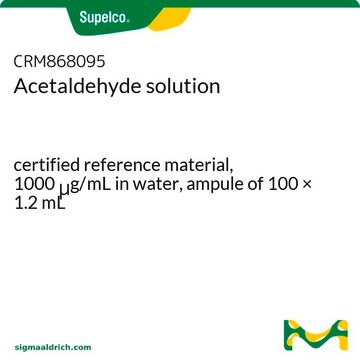506788
Acetaldeído
PESTANAL®, analytical standard
Sinônimo(s):
Etanal
About This Item
Produtos recomendados
grau
analytical standard
Nível de qualidade
densidade de vapor
1.52 (vs air)
pressão de vapor
14.63 psi ( 20 °C)
linha de produto
PESTANAL®
Certificado de análise (CofA)
current certificate can be downloaded
temperatura de autoignição
365 °F
Lim. expl.
60 %
embalagem
ampule of 1000 mg
técnica(s)
HPLC: suitable
gas chromatography (GC): suitable
índice de refração
n20/D 1.332 (lit.)
p.e.
21 °C (lit.)
pf
−125 °C (lit.)
densidade
0.785 g/mL at 25 °C (lit.)
aplicação(ões)
agriculture
cleaning products
cosmetics
environmental
flavors and fragrances
food and beverages
personal care
Formato
neat
temperatura de armazenamento
2-8°C
cadeia de caracteres SMILES
CC=O
InChI
1S/C2H4O/c1-2-3/h2H,1H3
chave InChI
IKHGUXGNUITLKF-UHFFFAOYSA-N
Procurando produtos similares? Visita Guia de comparação de produtos
Categorias relacionadas
Descrição geral
Aplicação
Informações legais
Palavra indicadora
Danger
Frases de perigo
Declarações de precaução
Classificações de perigo
Carc. 1B - Eye Irrit. 2 - Flam. Liq. 1 - Muta. 2 - STOT SE 3
Órgãos-alvo
Respiratory system
Código de classe de armazenamento
3 - Flammable liquids
Classe de risco de água (WGK)
WGK 3
Ponto de fulgor (°F)
-38.0 °F - closed cup
Ponto de fulgor (°C)
-38.89 °C - closed cup
Equipamento de proteção individual
Eyeshields, Faceshields, Gloves
Escolha uma das versões mais recentes:
Já possui este produto?
Encontre a documentação dos produtos que você adquiriu recentemente na biblioteca de documentos.
Os clientes também visualizaram
Protocolos
-Tolualdehyde; Valeraldehyde; Isovaleraldehyde
Separation of Acetone; Acetic acid; Propionic acid; Ethyl butyrate; Ethanol; Isoamyl acetate; Isobutyric acid; 3-Methyl-2-butanol; Methyl acetate; 1-Propanol; Acetal, ≥98%, FG; 2-Methyl-1-pentanol; Butyl acetate; Ethyl propionate; 3-Pentanol; 2-Pentanol, 98%; Ethyl isobutyrate; Isobutyl acetate; Acetaldehyde; Furfural; Butyric acid; Methanol; Ethyl acetate
Global Trade Item Number
| SKU | GTIN |
|---|---|
| 506788 | 4061837424090 |
Nossa equipe de cientistas tem experiência em todas as áreas de pesquisa, incluindo Life Sciences, ciência de materiais, síntese química, cromatografia, química analítica e muitas outras.
Entre em contato com a assistência técnica








